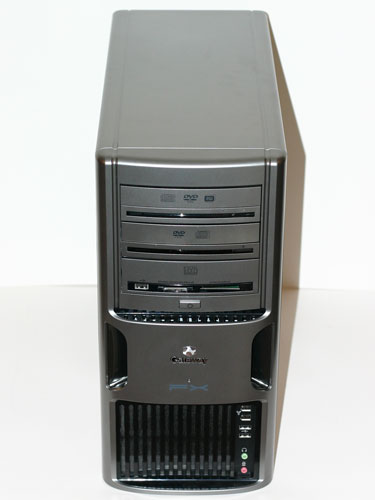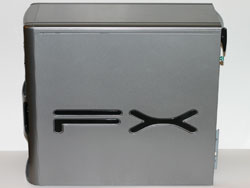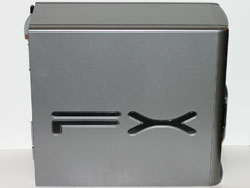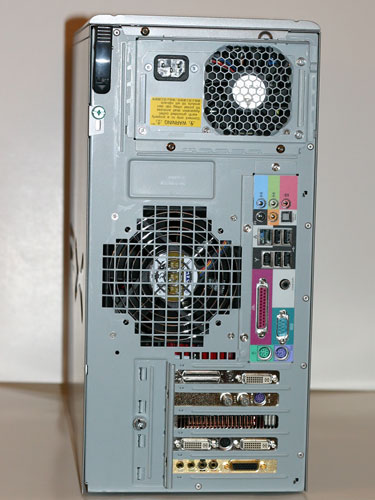Gateway FX530: Mad Cows and Quad Core Overclocking
by Jarred Walton on February 9, 2007 12:01 AM EST- Posted in
- Systems
Exterior Appearance
From the outside, the Gateway FX530 reminds us a lot of the Dell XPS 410 we looked at a while ago. It won't win any awards for being the most attractive case on the block, but it certainly doesn't look bad. The majority of the case is a metallic silver/gray color, with black accents. The case is also available with slightly modified accents in red, blue, or copper. These color changes primarily affect a small part of the front panel as well as the FX logo on the sides of the case.
The front of the system comes with two externally accessible 5.25" drive bays, both of which are occupied in our test configuration. Note that at present gateway does not give the option of including a Blu-ray or HD-DVD optical drive, so the top bay is occupied by a 16X DVD+/-RW unit and the lower bay has either a second identical optical drive or a DVD-ROM/CD-RW combo drive (or it can be left empty on certain models). Below the optical drives is what appears to be a third 5.25" drive bay, but in reality this is a cover over two internal 3.5" drive bays. One of these bays houses the 9-in-1 flash memory reader, and there is no option to install any other externally accessible 3.5" drives. (Death to the floppy - Hooray!) The middle of the front panel is unadorned except for the Gateway logo, with vents on the side for the CPU cooling to draw in fresh air. The bottom of the front panel is dominated by additional ventilation slots that will help to cool the hard drives, and in the bottom right are headphone and microphone jacks, two USB ports, and two FireWire ports.
The right and left sides of the case are identical and are the same silver/gray color with the FX logo emblazoned in the middle. As mentioned previously, the color of the FX logo can be customized, but otherwise there's not much to see. The right panel can be removed to access the interior of the case, and the design is such that all of the ventilation comes in the front of the chassis and is expelled at the rear. This sort of design works well for people that put their PCs in desk cabinets, as otherwise the side ventilation is blocked.
As usual, the rear of the case is home to the majority of the external connections. At the top is the power supply, and below this is the I/O panel. Many of the larger system builders are now moving towards legacy free I/O panels, which means no PS/2 ports, and no serial or parallel ports either; instead, you often get additional USB ports. Gateway bucks that trend here by including a parallel port and a COM port as well as PS/2 mouse and keyboard ports, so people will still be able to use most legacy devices. There are four more USB ports, a FireWire port, and a Gigabit Ethernet port. Five audio jacks allow for 7.1 audio along with a microphone, and optical and coaxial S/PDIF output is also provided. For systems with a sound card, of course, that will take priority over the integrated audio.
To the side of the I/O panel is a large 120mm fan exhaust, and the fan is also temperature controlled allowing it to spin at lower speeds and generate less noise when the system is idling. Below the I/O panel and fan are the five expansion slot brackets, all of which are occupied on our test system. At the top is an X1950 XTX CrossFire card, followed by the ATI Theater 550 TV tuner. The second X1950 XTX card is next, and at the bottom is the Creative X-Fi soundcard. A thumbscrew holds a metal plate in place that helps to secure all of the expansion cards. You can also see the single thumbscrew and lever at the top-left of the case that are used to remove the side panel.
One thing that isn't apparent from looking at the case is how heavy it is. This is easily one of the heaviest cases we have picked up in recent memory, particularly when we consider that it's not all that large. Certainly all of the components in the interior contribute to the overall weight, and even though the system is heavier than we expected it's not too heavy. Still, this definitely isn't a lightweight aluminum chassis. If you like to move your PC around a lot, that might be somewhat annoying, but for most people the weight of a PC isn't an important factor. One benefit is that the system also seems to be extremely sturdy (outside of a few plastic parts), and it feels like it could take a lot of abuse. Not that we recommend beating up on your computer, but you don't feel like you have to handle this case with velvet gloves.
From the outside, the Gateway FX530 reminds us a lot of the Dell XPS 410 we looked at a while ago. It won't win any awards for being the most attractive case on the block, but it certainly doesn't look bad. The majority of the case is a metallic silver/gray color, with black accents. The case is also available with slightly modified accents in red, blue, or copper. These color changes primarily affect a small part of the front panel as well as the FX logo on the sides of the case.
 |
| Click to enlarge |
The front of the system comes with two externally accessible 5.25" drive bays, both of which are occupied in our test configuration. Note that at present gateway does not give the option of including a Blu-ray or HD-DVD optical drive, so the top bay is occupied by a 16X DVD+/-RW unit and the lower bay has either a second identical optical drive or a DVD-ROM/CD-RW combo drive (or it can be left empty on certain models). Below the optical drives is what appears to be a third 5.25" drive bay, but in reality this is a cover over two internal 3.5" drive bays. One of these bays houses the 9-in-1 flash memory reader, and there is no option to install any other externally accessible 3.5" drives. (Death to the floppy - Hooray!) The middle of the front panel is unadorned except for the Gateway logo, with vents on the side for the CPU cooling to draw in fresh air. The bottom of the front panel is dominated by additional ventilation slots that will help to cool the hard drives, and in the bottom right are headphone and microphone jacks, two USB ports, and two FireWire ports.
 |
 |
| Click to enlarge | |
The right and left sides of the case are identical and are the same silver/gray color with the FX logo emblazoned in the middle. As mentioned previously, the color of the FX logo can be customized, but otherwise there's not much to see. The right panel can be removed to access the interior of the case, and the design is such that all of the ventilation comes in the front of the chassis and is expelled at the rear. This sort of design works well for people that put their PCs in desk cabinets, as otherwise the side ventilation is blocked.
 |
| Click to enlarge |
As usual, the rear of the case is home to the majority of the external connections. At the top is the power supply, and below this is the I/O panel. Many of the larger system builders are now moving towards legacy free I/O panels, which means no PS/2 ports, and no serial or parallel ports either; instead, you often get additional USB ports. Gateway bucks that trend here by including a parallel port and a COM port as well as PS/2 mouse and keyboard ports, so people will still be able to use most legacy devices. There are four more USB ports, a FireWire port, and a Gigabit Ethernet port. Five audio jacks allow for 7.1 audio along with a microphone, and optical and coaxial S/PDIF output is also provided. For systems with a sound card, of course, that will take priority over the integrated audio.
To the side of the I/O panel is a large 120mm fan exhaust, and the fan is also temperature controlled allowing it to spin at lower speeds and generate less noise when the system is idling. Below the I/O panel and fan are the five expansion slot brackets, all of which are occupied on our test system. At the top is an X1950 XTX CrossFire card, followed by the ATI Theater 550 TV tuner. The second X1950 XTX card is next, and at the bottom is the Creative X-Fi soundcard. A thumbscrew holds a metal plate in place that helps to secure all of the expansion cards. You can also see the single thumbscrew and lever at the top-left of the case that are used to remove the side panel.
One thing that isn't apparent from looking at the case is how heavy it is. This is easily one of the heaviest cases we have picked up in recent memory, particularly when we consider that it's not all that large. Certainly all of the components in the interior contribute to the overall weight, and even though the system is heavier than we expected it's not too heavy. Still, this definitely isn't a lightweight aluminum chassis. If you like to move your PC around a lot, that might be somewhat annoying, but for most people the weight of a PC isn't an important factor. One benefit is that the system also seems to be extremely sturdy (outside of a few plastic parts), and it feels like it could take a lot of abuse. Not that we recommend beating up on your computer, but you don't feel like you have to handle this case with velvet gloves.










26 Comments
View All Comments
akers - Tuesday, March 20, 2007 - link
Can anyone shead some light on why Gateway is delaying shipment on the FX530? I have had two delays so far and they cannot promise that it will be deliered by the second delay date. I have heard that there were so Vista problems but it was fixed by now.rfaster - Thursday, March 22, 2007 - link
My system arrived last week - I ordered it bare bones with the quad core OC'd to the 3.2.Specs - I put in a 8800GTX (fac OC'd to 600) - 2nd slot so its only running at 4X ( I did not realize this until I read the great article on this site), I'm running 2 150 10K raptor's, 4GB 667 ram. The best I can do is low 9K's on 3DMark 2006 (Running Vista Ultimate 32bit). I'm seeing easy 1,200's from other folks with similar setups.
Question - Is the 4X for Slot 2 causing the SLOWNESS? As you pointed out in your article there is NO way to fit the 8800GTX into slot 1 - so I am trying to decide if I should accept the 4X speed on my $699 8800GTXOC - or ship this pc back. I hate to think that my $699 video card is a WASTE on this system due to the 4X?
rfaster - Thursday, March 22, 2007 - link
Akers - on the delay I was told they are having a difficult time sourcing the parts needed to build this system. I was a bit put off by the delay on getting this box -- reminded me of my experience with Alienware a few years back ----JarredWalton - Monday, March 26, 2007 - link
Right now, Vista plus 8800 GTX is probably going to be a bit slower than normal. Still, I wouldn't worry too much - you can see that your low 9000s score matches what I got in 3DMark06... which is really just a benchmark and not an actual game.Darkskypoet - Thursday, February 15, 2007 - link
Now, correct me if I am wrong... But One of the major hinderances to the Quad FX platform (yes I realize 2 dual core chips is power hungry, and inelegant vs a dual die Quad core) is NUMA, rather the lack of proper NUMA support in XP. Looking at the benchmarks (and in fact all Quad FX bench's) sites continue to use XP variants to benchmark the Quad FX systems vs Conroe. XP does not support NUMA, one article in particular I had read mentioned this fact explicitly, and also mentioned that in many cases accessing data in memory in a NUMA dumb system incresed memory latency SUBSTANTIALLY. Consider that in a NUMA dumb O/S, the data required for a process / thread assigned to one chip, could inadvertantly have it's data stored in memory directly linked to the other CPU. This alone hurts benchmarking scores like crazy. In reality a Quad FX setup, if benched with real SMP/ SMC aware software, should eek out a higher per core performance vs Quad Core Conroe, then an X2 vs Dual Core Conroe.I saw this because the interconnect superiority (When run with NUMA Aware O/S : Vista / Linux / Etc.) will show itself vs the somewhat limited FSB in use in Quad Core C2D implementations; thus increasing performance per core vs Quad Core C2D.
I'm not saying we're gonna see the Quad FX Systems out perform C2D systems here. However, given proper NUMA support, the Benches will be a lot closer. Added to that we can use 2xxx series opterons in QUAD FX, and it starts to become a bit of a nicer picture for AMD. The icing on the cake however, would be that one should expect to be able to drop 2 native Quad Cores on to the QUAD FX boards in the near future.
I believe Nintendo Summed it up for us previously, "Now you're playing with power". If AMD follows this track, then they have a platform out that is fully tested, and stable; running 2 NAtive Quad core chips for the Enthusiast market. As unknown as the Performance of K10 is at this stage, 8 cores with should be mighty interesting. Mighty interesting Indeed.
Anyone know of a Proper NUMA aware OS used in Quadcore C2D vs Quad FX benchmarking?
Tuvoc - Saturday, February 17, 2007 - link
Windows XP x64 edition DOES support NUMA. I have dual Opteron 265s (nicely overclocked from 1.8 to 2.2) and as long as the BIOS is set correctly, then Sandra reports the NUMA statusI also have an Intel Quad core, and it is blindingly fast....
roflsaurus - Tuesday, February 13, 2007 - link
BTX case?JarredWalton - Tuesday, February 13, 2007 - link
BTX is a new form factor that Intel came up with a couple years ago, but the computer parts manufacturers have been relatively slow to adopt it. Basically, it reorganizes the locations of various parts in order to allow for better cooling. Motherboards are also mounted on the offices side of the case, compared to ATX. So where you would open the left side of the case on an ATX system, on the BTX case you would open the right side. If you were to put an ATX motherboard and a BTX motherboard next to each other, on the BTX motherboard everything would appear to be "backwards".Tuvoc - Sunday, February 11, 2007 - link
They say Gateway had to increase the voltage to make the overclock stable - but by how much ? That would have been intresting to know. Also core temps under full load certainly would have been very interestingJarredWalton - Monday, February 12, 2007 - link
The motherboard doesn't appear to work all that well at higher FSB speeds, so Gateway's overclocking is accomplished via changing the multiplier. More on this in a moment.Voltages are also a bit odd. CPU-Z reports 1.238V, but the BIOS is set to 1.450V. Obviously, there's a pretty big difference, and which is more accurate I cannot say. That illustrates the problem with reporting CPU temperatures as well: the BIOS/motherboard implementation will have an impact, as they can read the thermistor differently. Basically, you only end up comparing the Gateway results to itself, and the important thing is that there were no issues with stability when running overclocked.
Back to the FSB stuff. The BIOS has support for adjusting FSB speed and RAM speed, but only in large steps. The FSB can be set to 533, 800, 1067, and 1333 - default being 1067 for Core 2. The RAM can be set to DDR2-400, 533, and 667 (or Automatic). Basically, all of these items select a ratio and bus speed. DDR2-533 represents a 1:1 bus/RAM ratio, while 400 is 3:4 and 667 is 5:4. Using those ratios, you can use the FSB-1333 speed to modify the overclocks a bit. I was able to run the bus at 1333 with DDR2-533 and a 10X multiplier to end up at a 3.33 GHz CPU speed (and a real DDR2 speed of 667).
RAM voltages can be adjusted as well, but only to 1.8, 1.9, 2.1, or 2.2V. I didn't play with these at all. No point in trying to fry Gateway's equipment. I would venture to guess that the CPU could run at 3.3-3.5GHz if you want to push things (3.33 seemed perfectly fine in somewhat limited testing), but again I don't want to push too hard and end up with a dead PC/CPU/RAM/mobo/whatever.
Hope that helps,
Jarred Walton
Editor
AnandTech.com